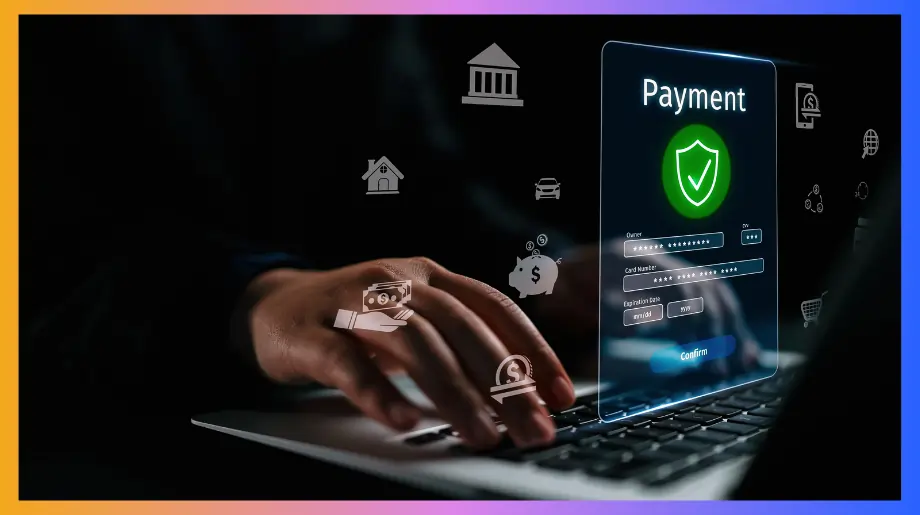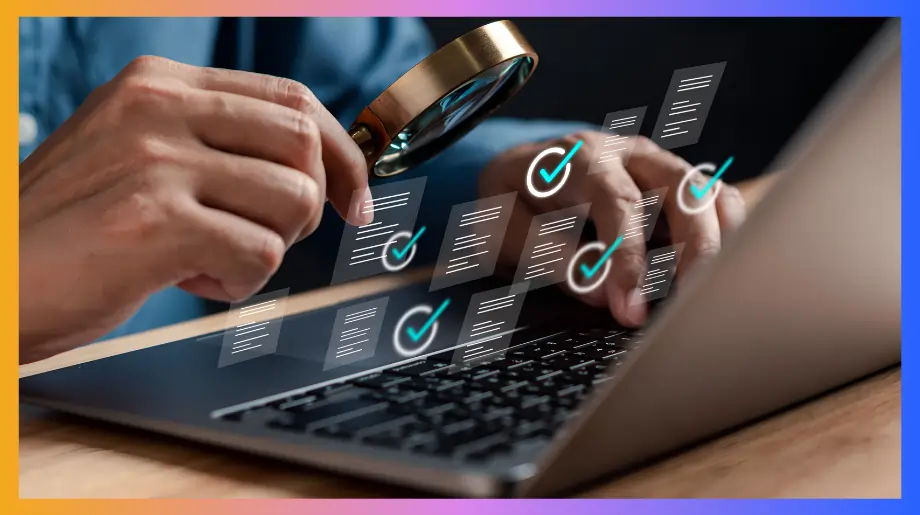In 2026 your bank account can face higher risk. Account takeover attacks grew more than double in just one year. Fraud also crossed 12.5 billion dollars worldwide. The rise is fast and steady. Banks now face threats that move quicker than traditional security can handle.
You cannot rely on passwords or pins anymore because what you know is not enough. What you are, your fingerprint, face or behaviour must now become your proof.
That is exactly where biometric authentication in banking steps in to give you smooth access and give banks the weapon they need to fight fraud that never sleeps.
What is Biometric Authentication in Banking?
Biometrics in banking is a security method that uses your physical and behavioral traits to prove who you are. It replaces passwords with your face, fingerprint or voice that only you can provide. Each check happens on your device so no secret travels online.
- Smart Identity Proof. Banks use your traits to prove you are real each time you act. Your fingerprint or face turns into a code that lives inside your phone. The system checks the code locally and never shares it.
- Trusted Access Flow. You open your app or approve a payment through checks that run inside your phone. The bank receives only a yes or no, nothing more. It saves time, removes password stress and stops most fraud before it begins.
- Mobile Trust Layer. Your phone becomes your guard. It scans your print or face before any transaction. Even if your device is lost it stays locked to you alone. This one step makes your money flow faster and blocks intruders who try to copy your path.
- Behavioral Shield. The system learns how you type, swipe and pause as your digital rhythm. When movement feels off it stops the task. You get unseen protection that runs in the background while you bank.
- Deep Security Frame. Real protection means layers that hold firm together. Face touch and behavior mix to make fraud costly and rare. Each signal checks the next to keep you safe.
- Global Standard Base. Rules now shape how banks handle your proof. Templates never leave your phone and each scan needs consent. Logs show every match and protect your right to privacy.
Why Do Banks Need Biometric Authentication?
Banks need biometric authentication for banking because passwords and pins can no longer stand against modern fraud. Attackers use stolen data and AI tools to act faster than any manual check. Biometrics give banks a way to know that you are truly you.
- Real People in a Fake World. Banks face fraud that runs nonstop. Stolen data and fake identities spread faster than passwords can protect. With biometrics in banking each person carries proof inside their body not on paper or file.
- Defense by Design. Most attacks happen when data travels. Here the match stays inside your phone not on a central server. The device only sends a yes or no to confirm you.
- Speed with Trust. People want simple sign-ins, not long forms. Biometrics in banking make it possible to open your app or send money with a glance or touch. The process stays fast for you and secure for the bank.
- Law and Proof. Global rules now require high-trust systems that protect user data. Biometrics in banking help banks meet these laws by keeping templates private and encrypted on your device.
- Core of Digital Banking. The purpose of biometric authentication for banking is not style but survival. It stops smart fraud fast without slowing real users. It gives banks vision into who acts behind the screen. What began as a tool is now the base layer of trust in modern finance.
Key Biometric Types Used in Banking
Banks now use biometric technology to build security that feels safe but still easy to use. Each type works on a unique human pattern that cannot be copied in full. Together these methods make fraud costly and trust easy.
You can see how each type plays a special role in keeping systems safe and smooth.
- Fingerprint Recognition. This is the most used form of biometric in banking. Almost every smartphone has a sensor that reads the ridge map on your finger. Banks use this for login payment and ATM access as part of advanced biometric security for banking.
- Facial Recognition. This tool checks the geometry of your face using a camera. It helps with remote onboarding where you upload a selfie for identity proof. The system runs liveness checks to spot masks and deep fakes. Banks prefer this for its speed and no touch flow.
- Iris Recognition. This method scans the color pattern inside your eye. The iris pattern does not change over life and is harder to copy than a face. High security banks and vault systems use this for staff access or large fund approval.
- Voice Recognition. Call centers and phone banking use voice as a passkey. The system reads tone pitch and speech pattern to confirm your identity. It stops social engineering and fake calls.
- Behavioral Biometrics. This is the silent watcher that studies how you type, move or swipe. It builds a unique rhythm for every user and tracks changes in real time. Banks use behavioral biometric for online banking fraud detection to detect bots and stolen devices. It does not ask for any action from you yet adds a deep layer of fraud defense.
Use Cases of Biometric Authentication in Banking
Banks now use biometric authentication not only for login but to rebuild trust across every stage of customer interaction. From opening an account to moving funds each step carries a biometric check that blocks fake activity and clears real users fast.
- Remote Onboarding. When you open a new account the bank must confirm you are real and present. Biometric onboarding uses a live selfie and ID match to link your face to your document.
The system checks blink and skin texture to stop deep fakes. Major banks use this to cut fake account creation and speed KYC. It replaces branch visits with secure digital proof. - Mobile Login and Payment. You unlock your banking app or approve a transaction with your fingerprint or face through biometric authentication. The match runs on your device using FIDO passkeys so your private data never leaves your phone. This brings both speed and safety. Banks use it to lower password resets and block phishing.
- ATM Access and Cardless Withdraw. ATMs now read fingerprints or palms for quick access. Some use biometric cards that match prints on the chip itself to stop stolen card use. When you touch the sensor it checks your print and your device key before allowing cash out. This step blocks cloned cards and shoulder-surfing frauds.
- Call Center and Voice Banking. Your voice can serve as your ID when you speak to a support agent. The system checks tone and rhythm before allowing access. It removes personal question steps that attackers can guess. This keeps support calls fast for real users and closed to imposters.
- Fraud Detection through Behavioral Biometrics. This quiet layer runs in the background as you bank. It studies how you hold your phone and move your mouse. If the pattern shifts the system blocks the action. It stops account takeovers even when passwords are correct, keeping you safe without extra steps.
What are the Considerations for Biometric Authentication in Banking
Biometric authentication brings both strong protection and new responsibility. Banks cannot just add sensors and call it secure. They must plan for accuracy, privacy and fairness from the start. When done right it builds trust that lasts when done poorly it turns into risk.
- Data Privacy and Storage. Every biometric trait is personal and cannot be changed. A password can be reset but a fingerprint cannot. Banks follow strict rules like GDPR and store templates on your device instead of a central server. If the device is lost cryptographic locks keep it sealed.
- Accuracy and False Results. Sensors are never flawless. Some wrongly let in others and some block the right ones. Banks must test systems in real conditions not labs. The goal is balance between safety and comfort. Low error rates matter most during high-value actions like transfers or approvals.
- Liveness and Spoofing Resistance. Attackers now use 3D masks and cloned voices to fool scanners. Banks add liveness checks for heat depth and small motion. Models must be trained on diverse real data to handle light age and regional changes.
- Regulation and Legal Compliance. Laws see biometric data as sensitive. Banks must get consent, define purpose and keep audit logs. Data must be deleted once its job is done. A weak policy risks fines and broken trust.
- System Integration and Accessibility. Not everyone can use a fingerprint or voice. Banks should build fallback routes that stay secure yet fair. Good design blends biometric checks with device security and behavior signals so no one is left out.
- Banks that follow biometric authentication in banking requirements as guiding rules not afterthoughts build systems that endure. In such a design biometrics stop being just a lock and become a shared trust between the bank and every user it protects.
Future Trends of Biometric Authentication in Banking
The next phase of biometric authentication in banking will move fast and build deeper trust between people and systems. Biometrics will no longer act as an add-on but as the main layer that defines how every digital action begins.
Future banks will join physical traits with data signals to form one living proof of identity. The progress will come not from new gadgets but from smarter ways to connect what already exists.
- Device Bound Passkeys and Decentralized Identity. Future banking will move beyond passwords and shared servers. Passkeys stored in your device will pair with your fingerprint or face to sign you in. The match stays on your phone so hackers get nothing to steal. Decentralized IDs will let you hold your data and share only proof while banks gain cleaner privacy control.
- AI Driven Behavioral Biometrics. Behavior will become a real trust marker. Systems will study small cues like how you swipe or pause. AI will know your rhythm and flag even slight changes. You will not need to confirm identity every time because motion itself will say who you are.
- Multi Modal Fusion. Banks will mix more than one biometric check at once. Face and voice or gesture and print will blend for higher accuracy. If one fails the other steps in. This balance makes fraud costly and keeps logins smooth across every region and device.
- Liveness Intelligence and Deep Fake Defense. As deep fakes grow smarter so will detection. Systems will read depth heat and micro motion to spot fake visuals. Voice tools will sense breath and vibration to stop clones. AI will play both sides but banks will aim to keep defense one move ahead.
- Privacy First Architecture. Privacy will guide every new rule for biometrics in banking. Systems will prove matches without exposing personal data using zero-knowledge checks. Banks will publish reports to show that your identity stays yours. In this design trust becomes measurable and security turns invisible yet unbreakable.
- The Future View. Biometrics will act as both shield and signature. They will link who you are to what you do with speed and certainty. You will not need to recall passwords or fear leaks because your proof will live safely in your own hands.
How to Secure Banking Systems with Biometrics
Securing banks with biometric authentication means building trust that lives inside every device. Each login checks who you are through face touch or behavior instead of passwords. Privacy stays local and fraud dies early. Real safety learns and adapts. Infisign takes this vision further by turning every sign into active defense.
Infisign’s UniFed and IAM Suite bring the full strength of biometric authentication in banking into one place. They turn complex sign-in systems into smooth secure flows.
Every login becomes passwordless and every account stays guarded by live identity checks. With Infisign banks move from scattered tools to one trust layer that runs fast and feels simple for every user.
Core Authentication and Access Control
- Infisign’s Passwordless Authentication. Infisign removes passwords fully and replaces them with device passkeys that live inside secure hardware. You sign in through a fingerprint face or iris. Each match happens only on your device through FIDO2 and WebAuthn.
- Infisign’s Smart Multi Factor Authentication. Infisign uses Adaptive MFA that changes based on real time risk. The system studies your device, your role and your location to decide when to add more proof. You verify yourself through fingerprint, face, mobile approval, one time code, or security key.
- Universal Single Sign. Infisign fits into the banking flow as a clean entry point. Infisign sets up in about 4 hours from start to finish. With social login already inside the system you let users sign in through Google or Facebook without making new passwords.
- Infisign’s Conditional Access Policies. Infisign monitors user actions and reacts to unsafe moves. If a basic role tries to open admin tools or download sensitive files the system stops the step.
Customer Identity Protection Layer
Infisign builds a protection layer that sits directly on customer login.
- Infisign’s Login Thresholds and IP Throttling. Infisign keeps login activity safe by setting firm limits on every attempt. It monitors how users sign in and slows down unsafe requests before they grow into attacks. Brute force attempts stop early while the system keeps running without pressure.
- Infisign’s Impersonation Control. Infisign stops fake access by letting trusted staff act only within approved limits. When support teams need to help a user the system records each action clearly.
Identity Sync and Control
- Infisign’s Easy and Unlimited Directory Sync. Infisign keeps all user data current across systems so biometric access always connects with the right profile. It joins tools and user directories in one simple path. When a role or device changes the update appears instantly.
- Infisign’s Automated User and Access Management. Infisign builds a secure flow where user access updates itself without manual steps. AI handles how accounts are created and removed across all apps. Tenant management keeps each bank or branch separate while data stays safe within its own space.
Governance and Compliance Framework
- Infisign’s Compliance and Auditing. Infisign meets strict privacy and data protection rules. It tracks every login and user event and creates clear reports.
- Infisign’s Identity Governance and Administration. Infisign keeps access clean by giving every user only the rights they need. Extra permissions are removed as soon as they are not required. Access reviews happen on time without manual checks.
- Non Human Identity. Infisign gives the same care to bot and API accounts that it gives to human users. Passwords are removed from all service accounts. Rules define what they can reach. Tokens and certificates stay monitored at all times.
Advanced Security and Zero Trust Architecture
- Infisign’s Privileged Access Management. Each privileged session is tracked live so you see who did what and when. Just in time access gives temporary rights instead of standing ones. The principle of least privilege is built in by default so permanent access never exists.
- Infisign’s Zero Knowledge Authentication. Infisign lets users prove who they are without revealing private data. The system checks proof without ever storing the secret itself.
- Infisign’s Network Access Gateway. Users connect to internal apps through encrypted tunnels built with TLS. Each tunnel keeps data safe while moving through the network. This gateway extends Zero Trust control across on premise and hybrid systems.
- MPWA and Password Vault. Infisign brings passwordless access to older banking systems through smart automation that replaces manual logins. The Password Vault keeps every secret in a protected space that no user can see. Older tools keep running safely inside a modern secure frame without new builds or code changes.
AI and Customer Experience
- Infisign’s AI Access Assistant. A user can ask for access with a short message in Slack or Teams. The system reads the request, checks the policy and gives a quick answer. If the request looks risky it goes to the right manager for review.
- Infisign’s Customer Identity and Access Management. Infisign builds one secure path for both banking teams and customers. It gives a single sign on, social login, and passwordless registration that feel easy to use.
- Infisign’s Deployment Architecture. Infisign runs on a cloud native base built for speed and stability. It works in public, private or hybrid setups so banks choose what fits their system best.
Infisign lets your identity open the way. You move and the system knows you. No password to remember. No pause in your path. Trust stays with you in every action.
Click to see the demo and feel how login can become this simple.
FAQs
What are the 5 main types of biometric authentication?
Fingerprint, face, voice, iris, and behavioral. Each uses a unique human trait to prove identity and secure digital banking without passwords.
Which banks use behavioral biometrics?
Major banks like HSBC, Barclays and Citi use behavioral biometrics to spot fraud by tracking user motion and typing patterns during online sessions.
Is biometrics safe for banking?
Yes, when data stays on the device and uses encryption. It removes password risk and reduces fraud though it still needs strong privacy and system checks.
What are the main problems with biometrics authentication?
Template theft, bias spoofing and limited accessibility. Once leaked biometric data cannot be changed so design and storage security must stay strict forever.





















